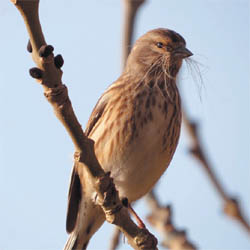| Wildlife
Newsletter for the Township of Dalkey May 2015 - Michael Ryan |
 Female
Linnet Female
Linnet Photo: M.Ryan |
It
was as if somebody had flicked a switch as the windy, wet, cold weather
of Good Friday transformed overnight to Easter Saturday’s beautiful
blue skies, sunshine and rapidly rising temperatures and it kick started
all sorts of activity. I had taken my own advice and left out little
clumps of dog hair on hedges and bushes in the garden as nest material
and saw it being gathered by greenfinch and dunnocks. Round the hills
it seemed as if birds were suddenly sprouting handlebar moustaches as
they filled their bills with stems and grasses, a female linnet taking
her nest building material into the gorse above the path. We were able
to spot two separate pairs of mistle thrushes who had started bringing moss and twigs to nests high in the forks of beech trees. I often wonder how they manage to breed successfully as they build highly visible nests on open limbs of trees and they seem to be in a constant state of battle with magpies and other potential predators. As we were watching one mistle thrush sitting in her nest a pair of jays appeared nearby. At first they were eating ivy berries then they too began gathering nesting material and flying off with it. We couldn’t see where they went but it looks like they’re not going to nest near last year’s site where they had some, probably unwanted, close neighbours in a pair of sparrowhawks. |
We saw three butterflies that same warm morning, two
peacocks and a small tortoiseshell which would have awoken from hibernation.
Back in the garden I was able to witness ladybirds mating, long periods
of total mmobility broken by short bursts of activity when the, presumably,
male on top would do little sideways wiggles. |
|
| We
were very glad to hear from a friend we met on the hill that a number
of red squirrels had taken up winter residence in a big garden off Killiney
Hill Road, up to four individual females at one time, to the delight
of the owner. Although we’d heard of sightings we ourselves hadn’t
seen any reds on the hill for a few months so were delighted to hear
they were still in the vicinity. Just a few minutes after we met our
friend as we headed up through the trees we were lucky enough to spot
the subject of our conversation, first one, and then another red squirrel
moving through some Scots pines. Looking up at them from below we were able to ascertain they were a male and a female, hopefully a breeding pair. We watched them for ages, chewing moss or fungus off the bark of a tree trunk and holding little stems of larch between their paws as they nibbled the fresh young buds, looking as if they were playing some type of woodwind instrument. Seeing them at all, feeding or just perched, is always a pleasure but your heart soars when you see them moving, leaping effortlessly from tree to tree as these did, covering great distances in seconds. You can’t help but be a bit concerned as they throw themselves from one slight branch to the next. Despite their agility and sharp claws squirrels do occasionally fall out of trees and indeed we did once see one fall out of a tree though thankfully its descent was broken by other branches and it recovered quickly, seemingly unharmed, after hitting the ground. |
|
|
You may have seen the very amusing video of sheep being herded by a Carlow farmer using a remote controlled drone. The drone itself is filming the sheep while it moves them around the fields and the film is speeded up to a soundtrack of music familiar from the Benny Hill shows. I saw the farmer being interviewed on TV where, when asked how his sheepdog felt about it, said the sheepdog was sitting outside the back door enjoying a Pina Colada, having retired from shepherding duties. Drones, as they get better and cheaper, are now used for all sort of activities some very worthwhile, some totally irresponsible and dangerous. When we were in Estonia last year we met a BBC reporter and a cameraman who were doing a piece about the popularity of bear watching. The sweeping overhead shots of vast forests they later used in their report were shot by a drone and drones are now often used by reporters to film trouble spots during warfare without putting a cameraman or pilot in danger. |
|
| There
has been a degree of controversy in the falconry community as to the
ethics of using drones to train birds of prey. Some birds have actually
been trained to attack the drones themselves which could result in injury
for the bird while other owners have dangled a lure, which would previously
have been hung from kite or balloon, underneath the drone which means
it is far enough away from the drone to ensure there is no collision
while simultaneously filming the bird spectacularly snatching the lure. Drones have been banned from some US parks due to their potential disturbance of resident raptors but elsewhere they have also proved to be very useful in some aspects of wildlife conservation. In Indonesia and Malaysia conservationists working to protect orangutans use drones to monitor the animals in areas of rainforest that would be virtually inaccessible to humans as well as monitoring illegal clearance of forest. In Africa the WWF (World Wildlife Fund) plans on using drones to help protect elephants and rhinos by tracking poachers from the air. In Britain drones have recently been used to monitor the nests of Hen Harriers; very endangered ground nesting raptors who would be very disturbed by any human presence but will apparently tolerate a high flying machine. |
 Male Wren Singing Photo M. Ryan |